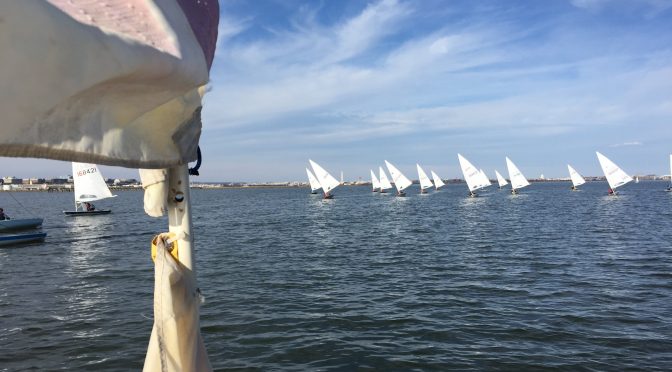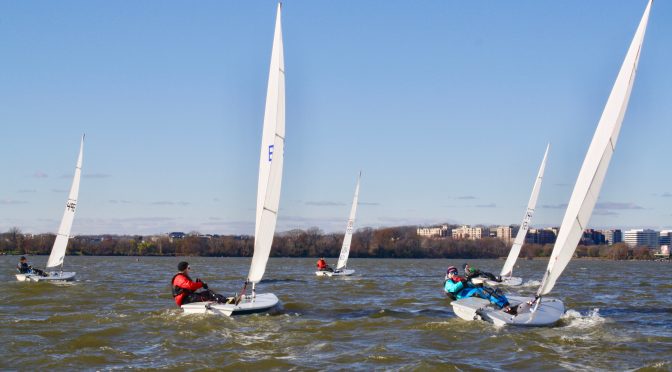Hi everyone,
Greetings from 3rd place. First – a huge thank you to Brian and his son for manning the committee boat and making sure we got in six races on a cloudy, cold, and ultimately rainy afternoon. A sunny and mild afternoon is what most of us would likely prefer and this was definitely not that! Thank you for taking one for the team.
The theme of the day was pin-favored starts, wind shifting more and more left, and a constant ebb (south-flowing) tide, so much so that earlier in the afternoon it seemed the current was doing more on the leeward legs than the wind! As for courses, we did our usual windward/leewards, mostly twice around.
Starts. These conditions made starts a bit more interesting. It was hard, if not impossible, to get over the line on starboard near the pin end, so that meant trying to be sure to be in the front row to allow for a quick tack to port (if starting on starboard). I got lucky in the first race and was able to start on port by the pin and won the race – but it was risky. As for the other starts, I did a mix of starboard and port starts with varying degrees of success. I noticed that I wasn’t the only one who got in some good port starts! But again, risky (but also fun to try).
Mark roundings. At the windward mark due to the current and the wind, the starboard layline was quite high and it was a little tricky gauging when to tack to ensure a bit of a cushion, but not too much. I mostly avoided hitting the windward mark by being very careful, including watching the mark as I rounded and steering accordingly. But during the last race I did hit it – and the boat overlapped to windward of me hit it as well! That kind of day. At the leeward mark, it was more the opposite problem. It was hard to do a close rounding and easy to be several feet downwind if one turned at the usual time/rate as if there was no current. I found that I could start to turn a bit early because I was drifting down the river so fast and this sometimes helped me pick up a few boats.
Upwind strategy. It generally paid to stay left-ish, especially towards the end of the day. At one point, I lost quite a bit of ground staying on port too long after the leeward mark and not heading back to starboard for a bit earlier in the leg. During one of the earlier races though there was actually more wind going slightly right at the top of the leg and I caught up a good bit. During another race, almost the entire beat was one big close-hauled tack/reach which made the start (especially location) super important as it was hard to pass with nearly no tacking opportunities.
Controls. This wasn’t a day where I did a lot controls-wise. Upwind – outhaul was a bit closer than a hand’s width (and tighter when the wind picked up); cunningham loose at the starts for pointing and then snugged; vang just snugged (mostly). Downwind – outhaul quite loose; cunningham off; just a bit of vang. Also (re control of self) – keeping my weight forward (and remembering to do this) helped too.
Other observation. For me personally, yesterday was a reminder to keep my head out of the boat more. It can be easy to focus on boat speed, especially when it is cold and I just don’t want to turn my head! – but my best races are when I’m looking around a lot more to see who is where, where they are pointing, where the puffs are, etc. Always something to keep working on. Related – thank you to those lovely folks who were good about yelling “starboard!” – I appreciated it!
Finally, it has been so awesome to have so many of us out there Sunday after Sunday. After spending many winters with a fair bit of travel, being able to sail regularly with you all has been a big silver lining of this pandemic. Looking forward to many more weeks of the season!
Scores via Farley attached (thank you, Farley!)
Hope everyone is having a good start to the week!
Laura


